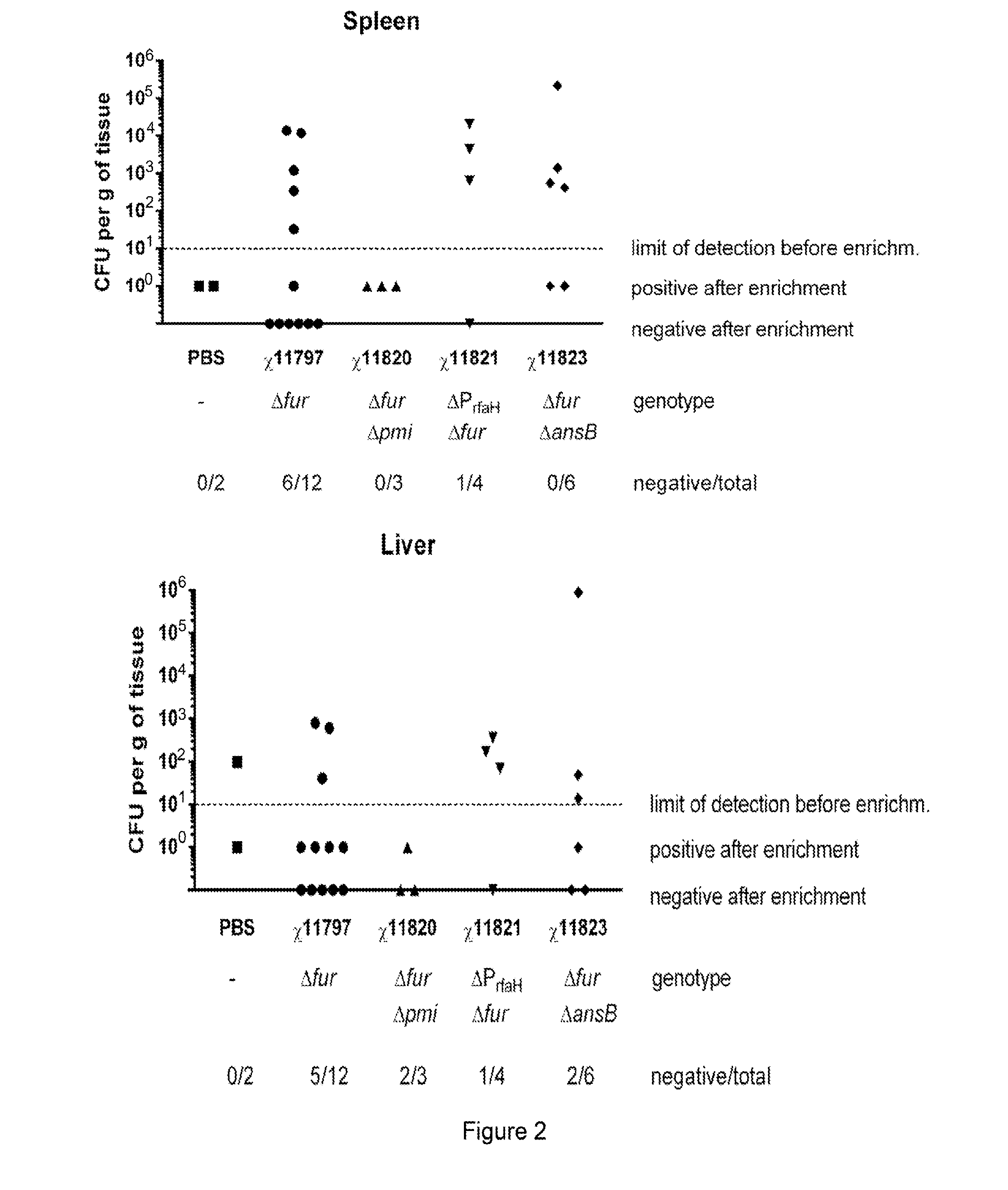Live salmonella vaccine and methods to prevent fowl typhoid
a salmonella vaccine and live salmonella technology, applied in the field of live salmonella vaccine and methods to prevent fowl typhoid, can solve the problems of significant economic problems of fowl typhoid, limited possibility of disease prevention through combination of hygiene and housing improvement, and unknown risk of reversion to wildtyp
- Summary
- Abstract
- Description
- Claims
- Application Information
AI Technical Summary
Benefits of technology
Problems solved by technology
Method used
Image
Examples
working example 1
[0036]Escherichia coli and S. Gallinarum strains were routinely cultured at 37° C. in LB broth or on LB agar. Cultures of S. Gallinarum mutants were supplemented with 0.05% mannose (Sigma-Aldrich, St. Louis, Mo.) (for Δpmi-2426), 0.2% arabinose (Sigma-Aldrich) (for ΔPrfaH178::TT araC PBAD rfaH, hereafter ΔPrfaH178) or chloramphenicol (15 μg / ml; Sigma-Aldrich) (for Δfur-453::cam). Carbohydrate-free nutrient broth (NB) was used for growth when determining LPS profiles. Strains were grown in NB without mannose (for pmi strains) or arabinose (for ΔPrfaH178 strains) overnight and subcultured (1:100) into fresh NB with or without the appropriate sugar for a second passage. LB agar without sodium chloride and with 7.5% sucrose (Sigma-Aldrich) was employed for sacB-based counterselection. MacConkey plates with 1% mannose were used to indicate sugar fermentation.
[0037]For animal experiments, S. Gallinarum strains were cultured in LB broth with appropriate supplements. Overnight cultures were...
working example 2
[0063]Immunogenicity of S. Gallinarum double mutants. We next examined two distinct genetic strategies for enhancing the immunogenicity of χ11797. It is well established that Salmonella O-antigen is required for efficient colonization of the chicken host. Mutations that result in the gradual loss of O-antigen in vivo can be used in Salmonella vaccine strains to enhance induction of high-antibody titers to outer membrane proteins. Thus, we investigated the possibility that introduction of a Δpmi or an arabinose-regulated rfaH mutation could enhance the immunogenicity of χ11797.
[0064]It is likely that all successful pathogens have various means to suppress host immune responses. An example of this in S. Typhimurium is ansB. The product of this gene—L-asparaginase II—suppresses host T cell responses important for clearance of a S. Typhimurium infection and S. Typhimurium ΔansB mutants are attenuated for virulence in mice. Thus, as an alternative approach for enhancing immunogenicity, w...
PUM
| Property | Measurement | Unit |
|---|---|---|
| Pharmaceutically acceptable | aaaaa | aaaaa |
| Strain point | aaaaa | aaaaa |
Abstract
Description
Claims
Application Information
 Login to View More
Login to View More - R&D
- Intellectual Property
- Life Sciences
- Materials
- Tech Scout
- Unparalleled Data Quality
- Higher Quality Content
- 60% Fewer Hallucinations
Browse by: Latest US Patents, China's latest patents, Technical Efficacy Thesaurus, Application Domain, Technology Topic, Popular Technical Reports.
© 2025 PatSnap. All rights reserved.Legal|Privacy policy|Modern Slavery Act Transparency Statement|Sitemap|About US| Contact US: help@patsnap.com


